West Seattle Bridge virtual meeting provides a status overview; Still set to reopen mid 2022
Wed, 07/21/2021
The West Seattle Bridge Virtual Meeting on July 21 provided an overview of the status of the repairs made to the bridge and a look at the Reconnect West Seattle program launched to provide alternatives to the bridge for travelers and commuters.
What follows is a verbatim transcript edited only to remove non essential conversation. Angie Thomson was the moderator for the meeting.
Sam Zimbawe SDOT DIrector
Thanks Angie and good evening, everyone welcome and thank you for being here. We're so glad that you decided to join us tonight on a beautiful evening.
There's so many things to do on a nice evening in Seattle in the summer tonight. We're even competing with an expansion draft for the new NHL team.
I'm Sam Zimbabwe I'm the director of the Seattle Department of Transportation.
And the last 16 months have been challenging for our community for many reasons, including the global pandemic and more.
Locally, the emergency closure of the West Seattle Bridge people call West Seattle. The city 's largest neighborhood. It's true, it's such a tight knit community.
I'm a public servant. I'm here to serve tonight, but I'm also a West Seattle resident raising a family here in the neighborhood. That largest neighborhood also extends to all of the communities of the Duwamish Valley. It's a diverse multilingual. Multicultural community and also when we see that in the sense of community that we have in our streets in our homes and during visits.
To the local businesses that we support, especially during trying times like these the West Seattle Bridge is a gateway to West Seattle and a symbol of the neighborhood. It's also clear that it's part of a system that affects all of the communities in the Duwamish Valley just as much as the Peninsula.
Since we made the difficult decision to close the West Seattle Bridge in March of 2020. Our priority has been first and foremost public safety.
The 100,000 travelers crossing every day. And the people and businesses in the communities surrounding and the spaces below the bridge. We immediately set to work to prepare repairing the bridge to prevent the cracks from growing and to stabilize the bridge.
That quick work enabled us to be where we are today moving ahead on the repairs that will enable us To return traffic to the bridge. I'm very pleased tonight to confirm that we are on track to reopen the West Seattle Bridge in mid 2022. We remain on schedule.
Another priority is to build the projects that balance and improve traffic conditions and congestion along the detour routes with pedestrian and bicycle safety in around and out of West Seattle.
Tonight you're going to learn more about the community led solutions to our collective challenges during an overview presentation of our entire West Seattle Bridge Program. In just a few minutes.
But before we dig in. We are going to hear from both Deputy Mayor David Moseley and Councilmember. Lisa Herbold, who are both tireless advocates for the communities of West Seattle and are real champions of the projects and the effort that we are undertaking here.
Councilmember Lisa Herbold
Thank you so much really appreciate it, great, being here and thank you for having this forum. I want to first start off by saying how much I appreciate doctor Zimbabwe, noting the importance of moving as quickly as possible to repair the bridge and really, really appreciate every day. The mayor 's decision to repair the bridge. Which can be completed several years more quickly than it would have taken to actually replace the bridge. We all know that the closure of the bridge and restrictions on the use of the lower level bridge have been very hard on our communities.our residents and our businesses alike. It's become more difficult to get to work Visit relatives friends and get to other parts of the city and for many, it's resulted in less time available to spend with loved ones and doing things that we like to do. Since the day that the bridge was closed. I've been hearing from district one residents and businesses about how traffic and speeding have increased on numerous West Seattle streets and, in South Park too. I've heard concerns about safety and about travel times.
SDOT has built over 200 projects so far to add signs and crosswalks. They've changed signal timing. They've improved pavement conditions and they've worked to slow traffic on neighborhood streets. I encourage them to continue doing more. And I really appreciate their openness to collaborating with the community on emerging on emerging issues. Like traffic on 16th Avenue Southwest near South Seattle College and Sylvan Way as detour traffic increased there. We really rely on the input of the community to identify these emerging issues as they as they come up so that we can work with and elevate need and get attention to those to those areas.
I think most people know that the council has already passed legislation committing to funding the repair of the bridge and the budget to fund safety projects and work such as the repaving that took place on Roxbury earlier this week.
The work that was done at the bottom of Highland Park Hill this weekend and I really thank Mike. All my council colleagues for joining me in acting quickly to provide necessary funding every step of the way.
Tonight SDOT is going to highlight a number of the projects that they've already completed and talk about more that are planned.
I appreciate SDOT prioritizing this work and it's been really good to see this level of progress made so quickly.
Now that businesses are opening up again. We hope that these projects will make it easier for people to spend time in our neighborhoods instead of driving through. We want people to support our local businesses.
You know, I I hear a lot of people contact me or asking 'Why are we doing these these transportation construction projects in West Seattle when it's so hard to get around?'
These projects are designed to make it easier to get around and safer. I want to thank the tireless advocacy of Congresswoman Jayapal from West Seattle and Senators Cantwell and Murray and the rest of our federal delegation.
And for believing in this project and obtaining important federal funding and then of course, as always. Thank you to everyone who's here with us today for taking time to listen and engage with us tonight and thank you for continuing to contact my office to let me know about where the needs.
Our greatest in in your communities, particularly the communities that are on the detailed detour routes and with that. Thank you for giving me an opportunity to make these opening remarks. I'll pass it back to our facilitator to start the program.
Angie Thomson
This is kind of the an overview of what we're going to talk about tonight. Just a general overall presentation on the repair work on the updates what's been going on. Some information on using the low bridge how that's been going as well as the work. That's been going on to keep people and businesses moving to and through West Seattle as part of the route connect West Seattle and the state, local and plan ahead effort.
And then we'll also talk a little bit about long term planning studies for the bridge going forward. So we'll spend a bit of time on that presentation and then we will have a good chunk of time for a Q&A session and then and then we'll adjourn the meeting.
After the meeting, we will post FAQ that addresses many of the questions that came up today and then if there are some that we don't get a chance to answer we also will post a PowerPoint and and the video and the recording of the meeting in case you or want to review it again Andrew Thompson
Deputy Mayor Mosley is now in the zoom so I wanted Deputy Mayor.
Deputy Mayor David Moseley
Mary Durkan is coming back today, from DC and I can tell you that a lot of her activities in DC over the last couple of days have been directly related to. support for the West Seattle Bridge and the adjacent streets that are important are part of that important corridor it's also of course, vital for the port of Seattle and the Northwest Seaport Alliance, so that has been a large part of her reason for being spending. A couple of days back in DC. In fact, she met with the Secretary Buttigeig Transportation Secretary yesterday. And earlier today, Sam and I were on the call with her with Deputy Secretary Trottenberg all on and as well as some of the members of the Washington delegation all on issues related to the West Seattle Bridge and I like. Councilmember Herbold want to thank our Washington delegation. That's been so helpful in this.
Certainly the Senators Cantwell and Murray and Congress members Jayapal and Smith. They've been very active and engaged in this and I don't know if Sam mentioned this earlier, but there is actually some a bit of good news tonight. I'm happy to announce that the state has just awarded us $12,000,000.00 in federal local bridge funds that it's federal money but it flows through the State Department of Transportation and they have awarded $12,000,000.00 for the West Seattle Bridge and this now totals of federal funds both directly from the feds and through the state of almost $38,000,000.00 so we are continuing to make progress on receiving the kind of support that we need for this vital transportation corridor and very thankful for everyone 's help on that.
Angie Thomson
I think we want to jump in now to all the information that you know. Start sharing that information that you all came here to come to here, and so we'll start by introducing Heather marks. Heather is the director of the West Seattle Bridge safety program. Heather. I'll turn it over to you.

Heather Marx
Good evening, everyone and thank you so much for joining us. Hopefully you can hear me and I have not proliferated the technological problems that we've been having, I am speaking to you from the sunny neighborhood of Fauntleroy and pleased to welcome you all here today. I want to thank everybody for your patience as we set this meeting up. We're doing this simultaneous translation and it's sort of the first time we've done this and so I appreciate everybody 's patience as we introduced all of that content so. As everyone here I'm sure knows the bridge has been closed since March of 2020.

After we found growing cracks in the structure during a routine inspection, the cracking was likely caused by insufficient post tensioning in the bridge as it was originally built so all of you were wondering what's wrong with the bridge. This is what is wrong. The post tensioning strands are steel rope that tighten the bridge and strengthen the concrete. We'll talk a lot more about that as we move through the material this evening. The bridge was built, according to the standards of the day. At that time there was less knowledge in the engineering community about some of the properties of concrete and a phenomenon that's called creep. No specific defect or fault was found in any of the designer construction documents. It was just a question of the engineering knowledge, not being where it needed to be for this kind of a bridge. Of course, as soon as we closed the bridge we immediately set to work on emergency stabilization work. You know that that's what was happening all of last year. We successfully halted the cracks from growing larger and preserved the ability for us to either repair or replace the bridge.
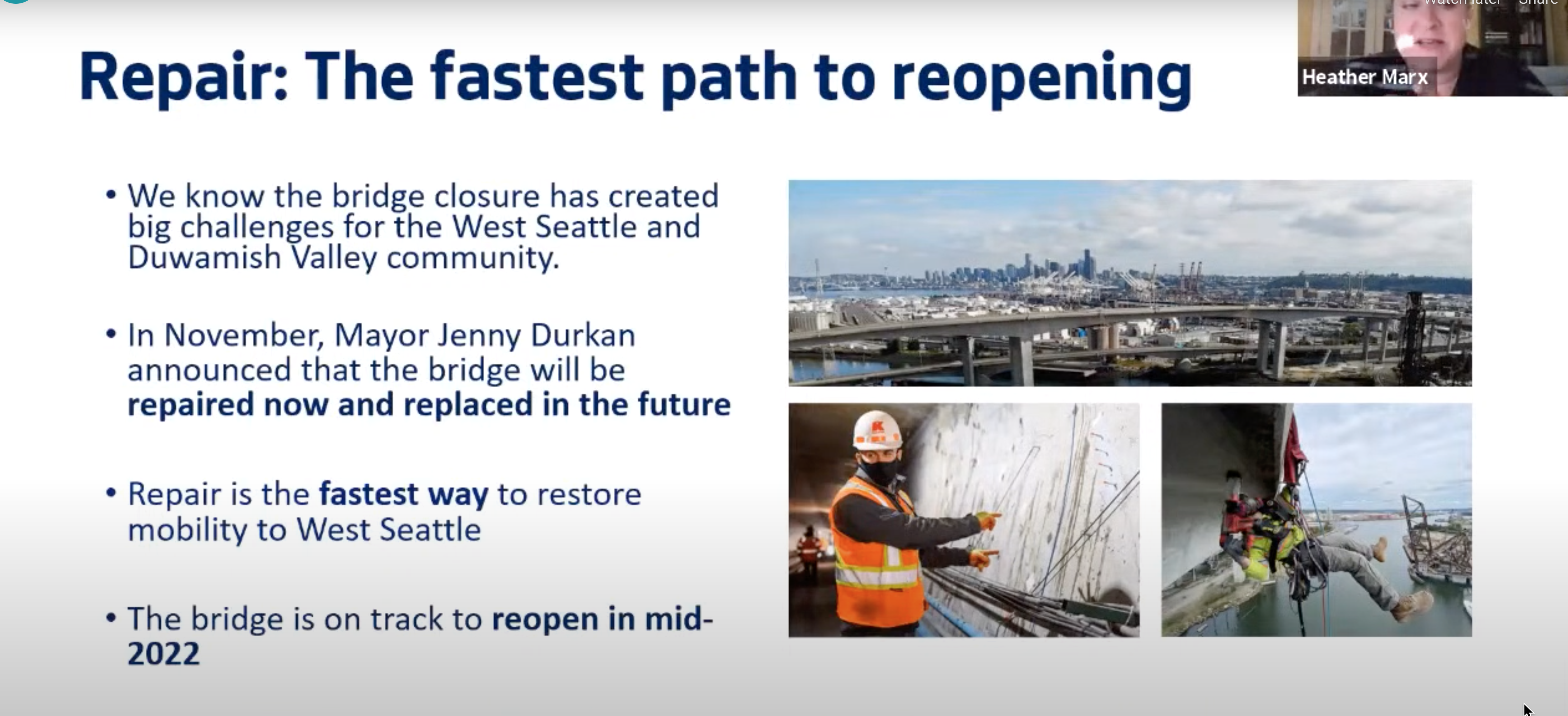
In November, you may recall the mayor made an announcement that we are going to repair the bridge because it's the fastest path to reopen the West Seattle Bridge and we know, I know that this bridge closure has created huge challenges for the West Seattle and Duwamish Valley communities as I mentioned I lived here. And repair is the fastest way to get a reopened bridge and we are on track to reopen in mid 2022. We would love, believe me, I would love to give you a very specific date when we're going to open it, but we're at intermediate design, not final design and so that very specific schedule of what date we're going to open is just not available at this point.
We continue to work with our contractors to define that schedule in in a very specific and deliberate way.
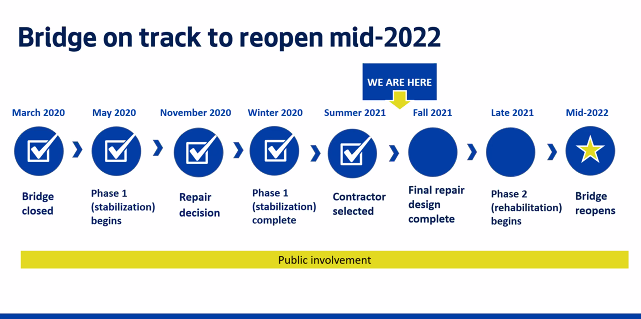
So anybody that knows me knows I know and I like nothing better than a checklist. So we have closed the bridge and completed the stabilization work we needed to. We achieved that repair decision from the mayor. We have completed all of the stabilization work and we have selected the contractor who is going to be doing the ultimate rehabilitation work. This fall, the very careful and exacting structural engineering design will be complete. The end of this year, we're going to begin the rehabilitation work and then as I've mentioned we expect to open the bridge in mid 2022.
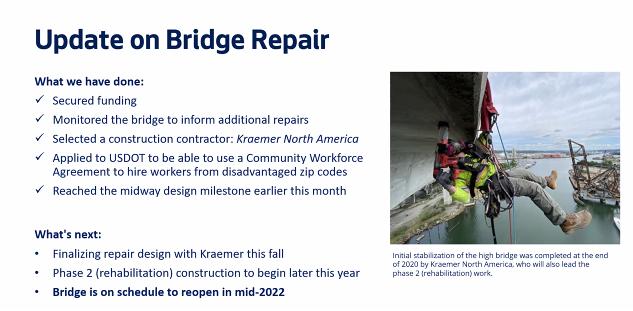
So it's such good news that deputy mayor, Moseley announced we have secured significant partnership funding from the federal government and some of those dollars passed through WSDOT. We're also working with other local partners to secure additional funds. We continue to monitor the bridge to inform additional repair work. We've selected Kraemer North America to do that repair work. We have applied to USDOT to be able to use a community workforce agreement that will allow us to hire workers from disadvantaged zip codes. That way we can bring the benefits of an open bridge as well as repairing the bridge to the community that it serves we've also reached that intermediate design milestone earlier this month. What's up next is finalizing those repair designs with our consultant WSP and our contractor Kraemer North America. Then later this year, we are going to begin those repairs and the bridge is on schedule to reopen in mid 2022.

So this is kind of a cool 3, D image that shows you the work that we're going to do.
This shows you one of the tail spans so there's the center structure which you're familiar with and then the 2 sides are called tail spans so center span and tail spans and most of the work on this bridge is going to take place inside the giant box girders that support the road there's going to be some external carbon fiber wrap. There's going to be additional post tensioning with steel cables on the inside of the bridge that will go from one tail span. All the way through to the other and then of course, some internal carbon fiber wrap. I want to note that structural engineering is a discipline that...It's very exacting. It's very precise bridges are designed to. They have a bunch of what they call members that support and reinforce one another and so any change in weight of the bridge, which you would get when you add a bunch of steel rope to the inside changes other parts of the bridge and so this is a very careful very highly mathematical process.
I just want to gently draw your attention to South Florida and the tragedy of those collapsed structures to reinforce for you how important it is that we get this design exactly right. Public safety is our number one responsibility and our number one concern. And so we are not going to move forward until we know that the designs are exactly right.
So I'd like to turn it over to my friend and colleague Maureen Sheahan. She's going to talk about the low bridge.
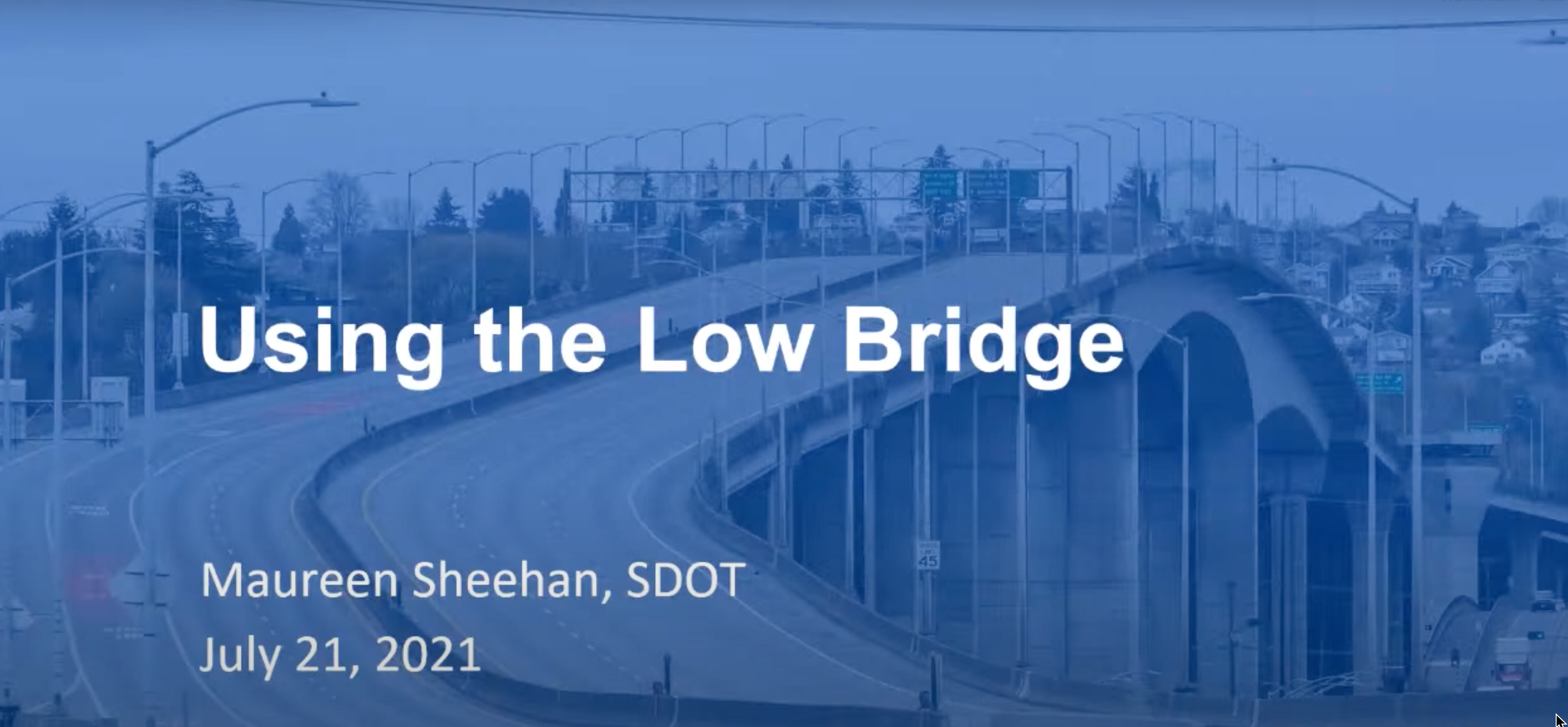
Maureen Sheehan
I am Maureen Sheehan. I'm with Seattle Department of Transportation. I am the Low Bridge Program Manager.
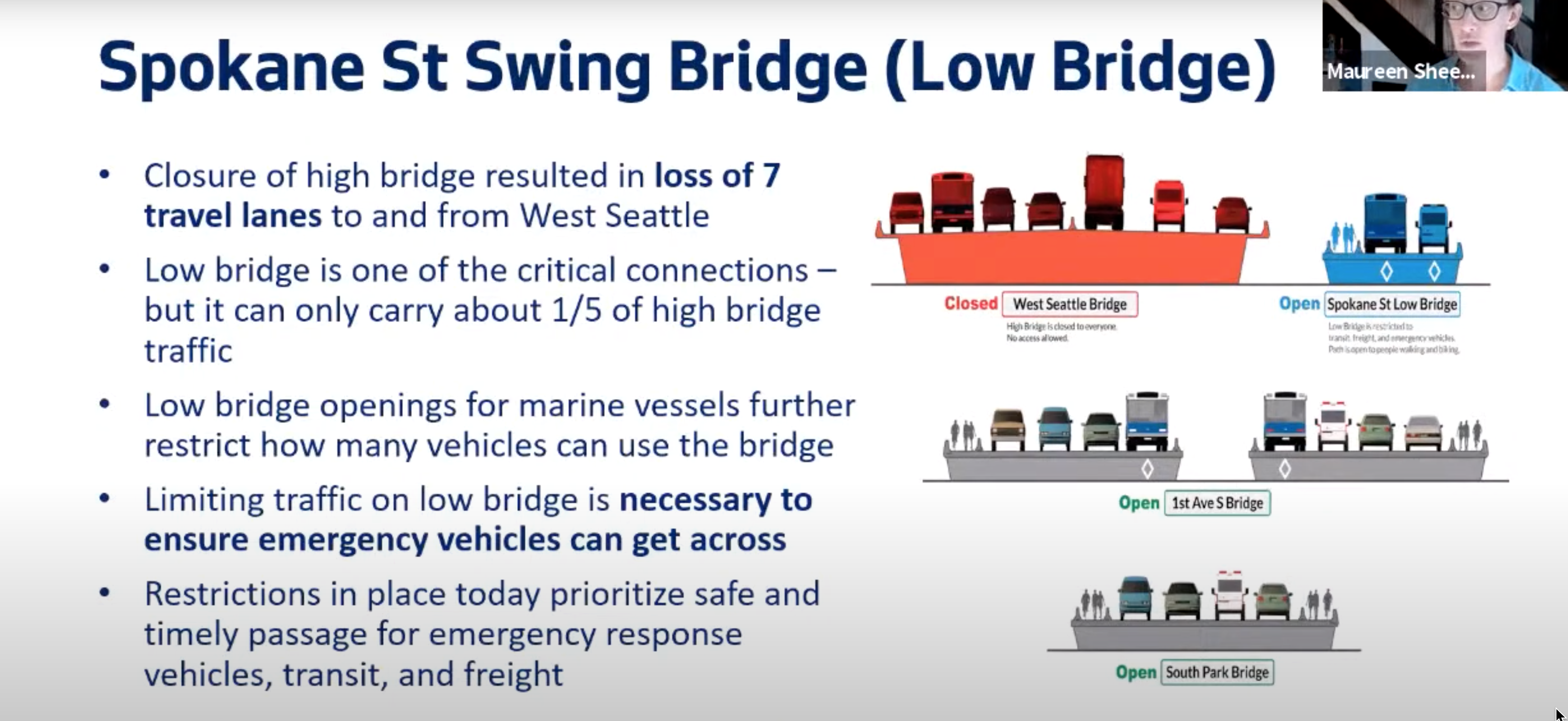
So when the High Bridge closed we lost about 7 lanes of travel, which is a huge loss. One of the remaining connections is the Spokane Street swing bridge, also known as the low bridge, which is located directly under the high bridge. The low bridge carries about 1/5 of the number of vehicles as the high bridge, it all also opens regularly for boats to pass which interrupts traffic on the bridge.
After closing the high bridge we had to immediately limit access to the low bridge to ensure that emergency vehicles including ambulances could get across the bridge when they had to.
We carefully prioritize low bridge uses because we know that it's extremely important to keep traffic moving so that the low bridge is accessible to people traveling on transit and to people driving trucks and workers headed to port facilities.
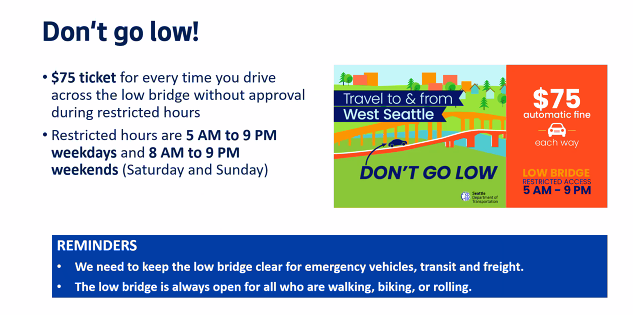
And this is why we had to put restrictions on who could use the low bridge in order to keep congestion down and to keep traffic flowing.
We installed an automated enforcement system. It's important that you don't use the low bridge during the restricted hours. If you do travel across the bridge during the day during those restricted hours you will receive a $75.00 ticket. At night, the bridge is open starting at 9:00 PM through 5:00 AM in the morning. Anyone can use the bridge during the week Monday through Friday. On weekends anyone can use the bridge between 9:00 PM and 8:00 AM.
And just a reminder that anyone can bike, walk or roll across the low bridge at any time.
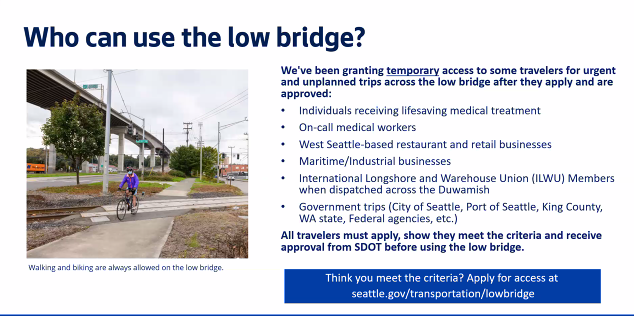
So we know a lot of community members would love to be able to use the low bridge and we've been closely monitoring the available space on the low bridge through extensive outreach to the community and data gathering. We were able to identify a few user groups that we allow to use the low bridge during restricted times, but only temporarily.
The following groups need to apply and be approved before they are allowed to use the low bridge so this includes
Individuals, receiving lifesaving medical treatment.
On call medical workers.
West Seattle based restaurant and retail businesses maritime and industrial businesses.
Union members who are being dispatched to port facilities as well as government vehicles. Again, all travelers must apply and they must meet the criteria and receive approval from SDOT before they can use the low bridge. If you think that you fall into one of these groups feel free to request access at the link on our website.
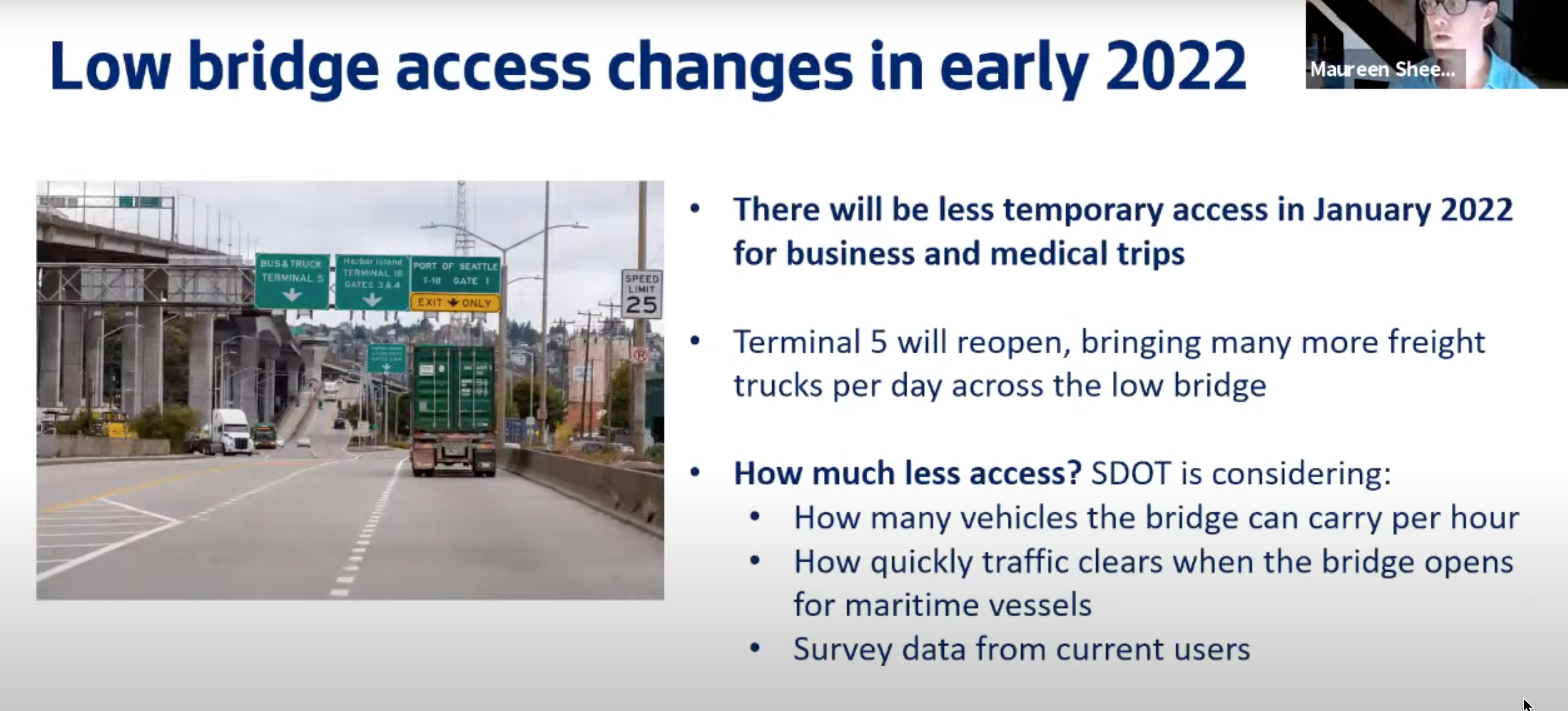
So, in 2022, there will be a significant reduction in the space available for us on the low bridge once Terminal 5 reopens.
Terminal 5 is being modernized by the Northwest Seaport Alliance to accept larger ships, strengthening our region's position as a key international port facility. It will reopen in January 2022. And when it does there'll be more trucks traveling across the low bridge than there are today.
We're currently assessing how much space will be available by looking at how many vehicles, the bridge can carry per hour. How quickly traffic clears when the low bridge opens for those maritime vessels as well as survey data from our current users. If you are a current user of the low bridge, an authorized user, we want to hear from you so please check your email later today and we'll be providing a survey to better understand your needs for the low bridge.
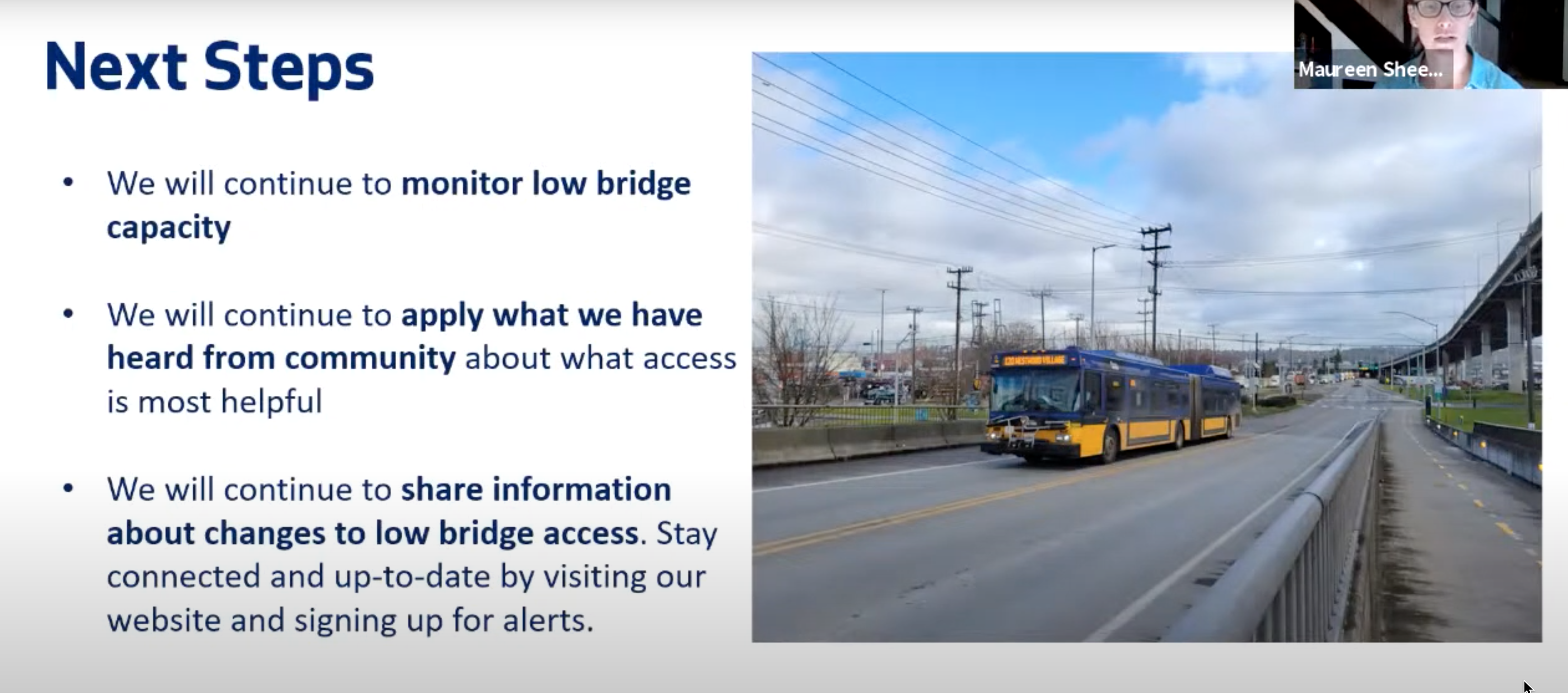
So our next steps for the low bridge is we're going to continue to assess how much space there is on the low bridge and look for opportunities for people to use it.
It's our intention to maximize the low bridge while also continue to make sure that emergency vehicles including ambulances transit and freight can get through and the corridor doesn't become overly congested.
We'll continue to seek out input from community members about ways we could help and again we don't want anyone to receive citations so please stay up to date on changes regarding the low bridge.
Angie Thomson
Sarah Zora is the Reconnect Seattle Mobility Manager, so we're going to turn it over to Sara to share more about how things are moving around and through West Seattle.
Sara Zora
I'm Sara I'm here to talk about the ways that we're trying to address some of the immediate issues that have been caused by the bridge closure.
So we know that closing the High Bridge and losing those 7 travel lanes that Maureen had addressed has been causing some major impacts for everyone.
We know that there's been increased travel volumes and travel times on the detour routes. There's been speeding and cut through traffic in the neighborhoods as well as environmental health impacts from the congestion and added pollution along those detours.
We know the travel impacts have been felt by everyone. We are especially feeling for the South Park Highland Park and Georgetown communities. These communities and neighborhoods are directly associated along the detour routes and they're experiencing heavy volumes of traffic as well as cut through traffic in their neighborhoods, so the bridge closures have impacts have been felt disproportionately by communities of color and lower income Seattleites.
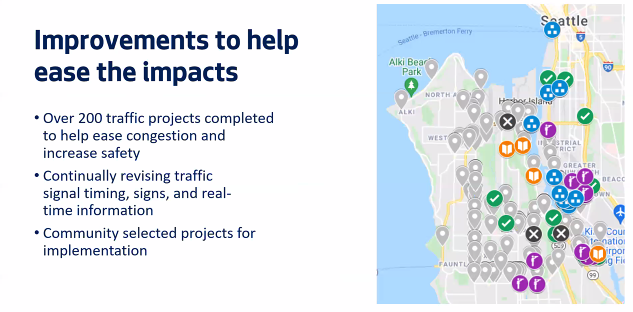
We're working on how to help ease these improvements through the Reconnect West Seattle program so if you see the map on the right hand side of the screen. We have implemented over 200 traffic projects. Traffic mitigation projects to really help the ease ease the congestion and increase safety and predictability for.
Whereas the map really reflects those 200 / 200 traffic mitigation projects as well as community prioritized projects. We are continually working with community to learn what and how they've been experiencing the bridge detour closure as well as. being very participatory with the city of Seattle, so that we can ensure that we're building projects to really help mitigate those issues that we're seeing in the neighborhoods. We're continually working on revising traffic signal timing, signage, real time information, paving different detour routes, to really ensure that we are focused on maintaining good predictability and accessibility on those routes the community projects are really important. And we build additional traffic signals. We've installed a lot of speed. Humps added radar feedback signs to help control the speeds and and allowing people to walk and and have more pedestrian mobility within the neighborhoods.
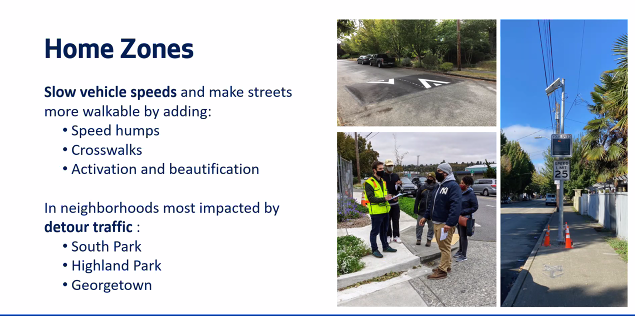
Part of those neighborhoods that we're really focused on like I said, are South Park Highland Park in Georgetown and we're implementing a program that we have at Sdot called Home Zones. It's really involving the entire neighborhood working together to promote and prioritize improvements that would help calm traffic in these neighborhoods,improve pedestrian mobility and safety as well as create some better activation and beautification such as adding street trees into these neighborhoods. We've already begun. We conducted an inclusive process in these 3 neighborhoods at the beginning of the year, including community safe. Covid safe community walks to really learn and listen and talk with community that's experiencing the impacts of the high bridge closure we have been implementing projects in the home zones with community and we'll continue to do so into 2022.
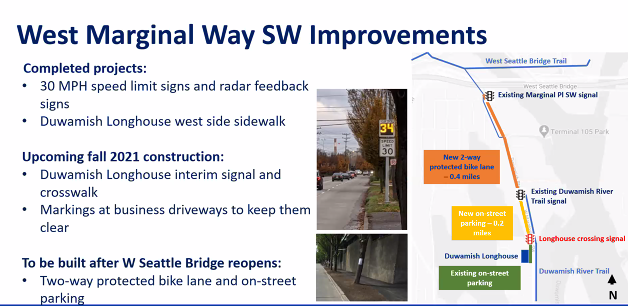
I really wanted to address a package of of improvements that were making on West Marginal Way.
As you all know West Marginal Way is a major detour route since the closure of the high bridge. We've seen about 15,000 an average of 15,000 vehicles per day using that route so we have a package of improvements to try and ensure that we're making West Marginal Way safer more predictable and more functional for all the travelers. We have completed a few projects already along the corridor such as installing 30 mph speed limit signs and radar feedback signs that was a citywide initiative to really try to focus on our vision zero goals by reducing speeds on major corridors.
We've also installed a Westside sidewalk to really connect and provide better access to the Duwamish longhouse upcoming here in the next couple months. We'll be installing an actual traffic signal and crosswalk for better access and safety and predictability for access to long at the Walsh longhouse at the Herring, South Park entrance.
And we'll be also including more markings on the pavement to ensure that business driveways, can be kept clear and accessible as West Marginal Way has seen some larger volumes of traffic.
In the future after the West Seattle High Bridge reopens we will be building a 2 way protected bike lane and on street parking within a 0.6 mile of the 2 and a half mile quarter. This is really to ensure and and maintain predictability for all users this will ensure and maintain the major truck street designation and freight mobility. This outside traveling that we're going to convert from a traveling to a 2 way protected bike lane or on street parking.
We'll just maintain that single southbound lane from the Chelan, 5 way intersection underneath the bridge structures and then into West Marginal Way. We're going to maintain that single Lane cross section for people driving vehicles until after the Duwamish Longhouse or it will open up again to a 2 Lane cross section on West Marginal Way. This really helps achieve our Vision Zero goals by eliminating zero traffic deaths and serious injuries on Seattle streets. It provides alternative options for people to get around their neighborhoods as well as committing to climate action goals that we have at the city as well.
I'll talk more specifically about near term improvements that we're making that construction just started last weekend to really improve traffic flow at West at the West Marginal Way Highland Parkway intersection. We know this is a major detour intersection and these improvements are really going to help it move more efficiently. The big primary driver of the intersection improvements is to ensure that we can have a a double left turn Lane from southbound. West marginal way to eastbound Highland Parkway at the same time as a right turning movement from westbound Highland Parkway to northbound West Marginal way, so you'll be seeing SDOT crews removing portions and whole traffic islands out there. W'ell be relocating the bus stop to the far side. The westbound side of the intersection on Highland Parkway and improve the curb ramps to really accommodate accessibility to those bus stops as well as adding accessible passing signals around that intersection. We will be doing this construction now as we have just started and we're going to be mostly leaning towards weekend work with our crews starting in early as morning hours as 3:00 AM so that we can try to be out of there when traffic starts picking up again, we will have maintained travel lanes during that construction. We expect to complete that construction by the end of the next quarter 3, September 30th.
I'm going to still stay on and talk a little bit more about being part of the response how how can we help with different travel options and help to stay local and plan ahead for when you do make trips across that Duwamish Waterway.
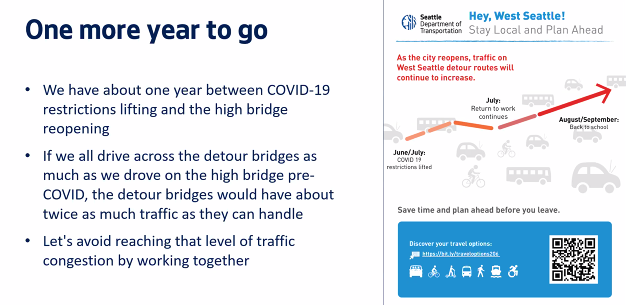
We do have one more year to go. We have had the COVID-19 restrictions lifted and the High Bridge will be reopened in about a year from now.
So we do have quite some time to go and we know that our travel times on the detour routes are increasing so we need to really have everyone work together about how to handle this level of congestion with the loss of those travel lanes that we will not get back until that high bridge reopen
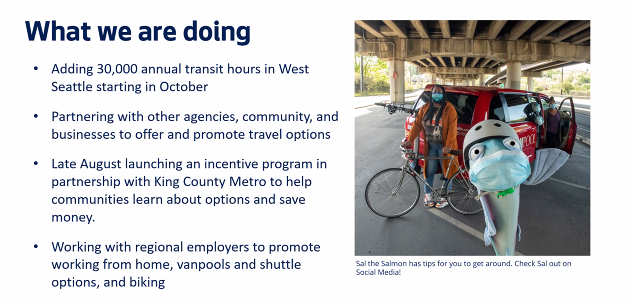
We will be adding 30,000 annual transit hours in West Seattle starting in October. We will be adding bus frequencies such as on the Route 50. We're going to be doubling that frequency to 15 minute headways. So you can get a bus from Alki to the SODO link station more frequently during the day. We're also partnering with other agencies such as King County Metro and other businesses in the community to really promote some of the travel options that we have.
And and we'll be working and going to community events to really try to promote different ways of traveling if you have the opportunity to try a way to make a different trip. We're going to be launching an incentive program towards the end of August to really help, and ensure that people have a system, a platform to use to really incentivize their trip. And we are working with large employers as well. So to really promote West Seattle people. Duwamish Valley employees to continue to work from home or to use their employer shuttles or van pools and bike if they can get to work in a different way than driving their personal vehicle.
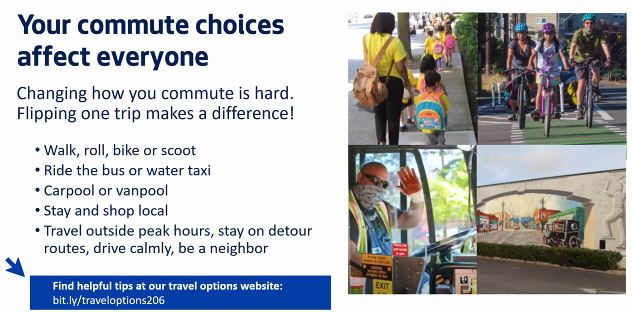
All of your choices do affect everyone so flipping a trip is really important. If you're able to change one trip that you can change to either walking or biking.
Riding your bus or taking water taxi or traveling and staying local is something that you can do. If you are traveling on the detour routes, we really recommend staying on those detour routes, not cutting through on neighborhood streets and trying to be a neighbor and know that you are with other West Seattleites Duwamish Valley residents that are trying hard to really find a way to work through the impacts that you're feeling with the high bridge closure. We do have tips on our travel options website as well if you need any other support. And I will pass it to Wes, who will talk about our bridge replacement study.

Wes Ducey

So my name is Wes Ducey and I'm the Project Manager for the long term eventual replacement of the High Bridge. I'll just kind of reinforce that with this timeline here, I live in West Seattle and I'm eagerly awaiting the reopening as well, mid 2022.
And we expect the bridge to last for another 40 years, which is setting our eventual replacement of the high bridge at about 2060. So, just want to kind of reinforce that separation of this work, which is very future focused which is a lot of the ongoing work to get our bridge back open to keep traffic flowing right now. We launched this study in June at the community task force. And we are taking this action now just to ensure that we're more prepared for the time when the time comes to replace the structure. This corridor is extremely constrained. There's existing infrastructure that is going to be activated at Terminal 5 there's planned the structure come into this corridor. We really need to do the work now to really think about where replacement will fit into this constrained corridor as it becomes more challenging in the future.
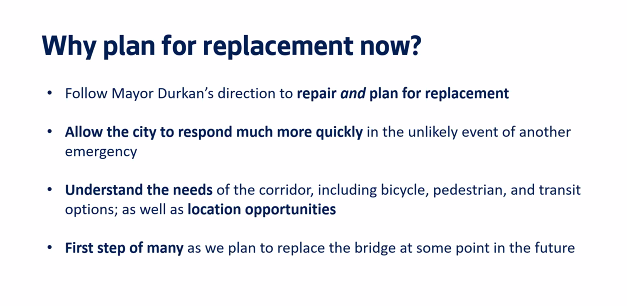
The real why for this work stems from Mayor Durkan's direction last November when she directed us to wisely repair but also continue the plan for replacement.
This will allow the city to respond more quickly if an unlikely event does occur between now and 2060 and it really, really amplifies the understanding that we're gaining about traffic moving across, through and to the Duwamish Valley and really carrying that understanding forward into this study work. We'll do a kind of a needs assessment of the different modes of traffic moving across the Duwamish Valley focused on a hybrid replacement, but the real focus of this study is to look at where the location of a replacement bridge would be best suited so we'll look to the North of the existing bridge to the South of the existing bridge, on line with the existing bridge is currently and a tunnel as well, and this step is really the first of many.
There are certainly other questions will ask as we get closer to the 2060 time horizon of a replacement such as size and type of a structure. We're really focused right now on the location. And doing some kind of feasibility work to see what can work and what can't and how we can minimize impacts to a lot of the operations that go on around the bridge. And this work is happening pretty quickly this year.
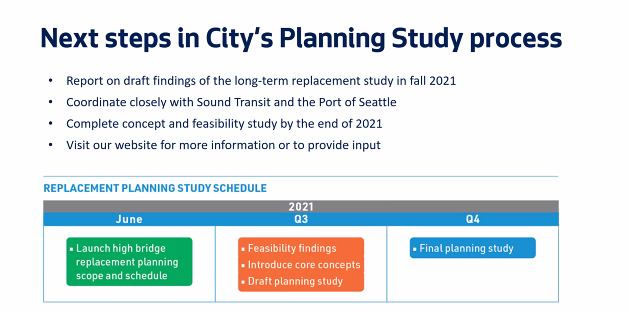
We're trying to be efficient in carrying that understanding forward in this study, but just doing this work very quickly so we'll report on the draft findings from our study later this fall in the community task force and have had ongoing will continue to coordinate with Sound Transit in the Port of Seattle. And then we are completing this study's work by the end of this year.
We'll be bringing that work back to at the end of this year to the Community Task Force but also posting on our website and really encourage you to find more information about this future focused work on our website.
Danielle Friedman who works on outreach and engagement for the West Seattle Bridge is just going to share one slide on how to stay up to date. And then we're going to go into the question and answer Danielle.
Danielle Friedman
Speaking of giving information we have a number of ways for you to be involved. It might also speak with your group. We're always happy to attend your meetings. You can email us at WestSeattleBridge@seattle.gov or call our multi lingual phone line.
And visit our website to keep up to date. There's lots of information on there about all the topics covered tonight and I encourage you to visit our website to subscribe and get email updates.
So we are ready for the Q&A session.
Angie Thomson
We've had a lot of questions submitted,
OK so I have a question here for Sam, Zimbabwe, Sam. What can be done to speed up the repair?
There does not seem to be any sense of urgency to complete repairs. The burden on West Seattle residents has been substantial and patient seems to be wearing thin.
Sam Zimbabwe
Thanks Angie and thanks for that question I can assure you that there is urgency in our work to achieve the repairs as Heather described earlier.
There is some very delicate design that still has to be done and then we have to procure materials and complete the repairs.Eeverybody at SDOT is working urgently to get those repairs done day in and day out. And although you can't see that work on the bridge today that that day is coming and we're working towards that as quickly as possible.
Angie Thomson
Question for Heather. Is the construction contractor on board now? Why hasn't the design been done over the 18 months the bridge has already been closed.
Heather Marx
So thank you very much for your question. Yes, the contractor is under contract right now and in fact, they are working. They are working with us to develop the final design design which has actually been underway for a significant portion of the closure. First they were designing the stabilization work that was necessary to keep the bridge from actually falling down. And then they started the design once we had the repair decision. They started the design in November of last year for this final rehabilitation work that we're doing so actually design has been going on for for the entire 18 months.
Angie Thomson
A question for Councilmember Herbold. Stay local in West Seattle is such a good idea. Can we promote more services in West Seattle? A Golf driving range next to the West Seattle Golf Course and hotels in West Seattle are needed too.
Councilmember Lisa Herbold
I'm happy to do whatever I can to promote more services in West Seattle and the use of the services that we have, I just got a really nice note from somebody on the chat about the information that I provide every week in my in my newsletter. If folks have ideas about how to put a focus on either a type of services that we have right here in West Seattle or for particular providers of those services, I'd be happy to use my newsletter to do that and I just want to also fit in this. How to how to promote all of the the great businesses we have here in West Seattle.
I want to thank the Office of Economic Development for everything that they are doing to support our small businesses during this difficult time, everything from working with SDOT in the in the allocation of the lower level bridge passes, but also in funding small businesses that are have been harmed up through the pandemic and are looking to open up their doors. So I think we all can do more. And I'm I'm happy to hear from you. On what you think I should be doing more of.
Angie Thomson
A question for Sarah on Water taxis. Have there been any thoughts on increasing the frequency of and extending the hours of the water taxi? Have you considered adding a passenger or water taxi? I think passenger ferry maybe or water taxi from Fauntleroy to downtown.
Sara Zora
Yeah, all those are great questions. Thank you. Yes, the water taxi is owned and operated by King County King County Marine Division So we have to work closely in partnership with our eight other agencies. They are on their summer sailing schedule now for the water taxi. Which is quite beneficial. They have more frequency during the day and at night time and water taxi ridership has been increasing so we have seen that that is a great benefit to for people to have choices in getting around.We did take a look at the potential for adding additional foot ferries potentially along the Duwamish waterway and the assessment we had seemed like it would not necessarily achieve the the mobility option in the time frame that we would need it in in order to. ensure that that option was available for prior to that hybrid reopening in 2022.
Angie Thomson
Once the bridge is repaired will work continue on a new bridge? The bridge couldn't handle the traffic prior to the closure, so just returning to the status quo seems shortsighted.
Wes Deucy
Well, since since we are looking 40 years ahead for the eventual replacement of the bridge. We are focused right now on best location for the replacement.
I think one thing I may have glanced over my presentation is there's a fair amount of work to just figure out how much traffic we keep flowing during construction of a replacement and that's that's a lot of good work to do right now to really hone on that location, looking at things like future number of lanes 40 years in the future or the type of the bridge would be something we'd revisit 10 to 20 years before. We're ready to replace it at a sooner time when there's more relevant modeling to to rely on for that information.
Angie Thomson
Maureen not open up the times to use the low bridge most of the time, especially on weekends? The bridge is mostly empty.
Maureen Sheehan
So we did recently extend the hours that the low bridge is open on the weekends, extending the morning hours to 8:00 AM instead of 5:00 AM and we continue to evaluate and look for opportunities. Right now our analysis shows that if opened the demand for the low bridge is high enough that traffic volumes would rise above the point where the bridge would be a reliable corridor for emergency vehicles transit and free.
Angie Thomson (introducing an audience member)
Jacob
Hey, I'm I'm a homeowner and on the weekends. I like to use Uber and Lyft to get to Capitol Hill and it currently seems that Uber and Lyft cannot use the low bridge from 9 to 5 when It's open to everyone and ultimately that means the cost to detour is put on to us and that's about 20 to $30.00 each way and I know the reason for not allowing Ubers from 9 to five so that residents can use the bridge. And I'm just kind of looking for an improvement here where maybe come from 11 to 5:00 AM. Uber can use the bridge because there's less residents using the low bridge at that time. Or maybe ideally Lyfts and Ubers can just use the low bridge from 9 to 5. Like everyone else. I know from 9 to about 11 there's quite a backup to use low bridge already less so on the weekends, which is when I personally would rather want to use Lyft to get to Capitol Hill. So I'm wondering if we can make some changes there. They help reduce my cost and increase safe driving choices for residents here in West Seattle.
Angie Thomson
Thanks Jacob, Maureen. I think maybe we send that one to you.
Maureen Sheehan
A similar response to the question earlier is we are always looking for opportunities to expand access.
It is a very finite resource and so trying to find groups that can fit within the access of the Low Bridge and we totally hear you about getting on and off and getting to and from West Seattle. I'm using Uber and Lyft, but right now that group I think is just too large for us to reliably be able to grant access to those folks and still have reliable access for those emergency vehicles.
Angie Thomson
This is a question for Heather.
It feels like there is construction happening everywhere like on delridge way. What are you doing to coordinate construction work while the bridge is closed?
Heather Marx
So that's a good question. Delridge is going to be finished in just a couple of months so we have not very much longer to wait until all of West Seattle can use the amazing improvement that is going to be a totally repaved and reconfigured Delridge.
We are coordinating construction and one of the things that we do is we try to do any construction that's necessary, not big giant things like Delridge that if we did that only at night or only on the weekends. It would be under construction, you know eternally.
We make sure that the work that we do for example, at Highland Parkway and West Marginal Way is early early in the morning or we make sure the paving that we just did on Roxbury was in the middle of the day instead of during the peak times.
It's not perfect. We really do want to make sure that we're taking care of the especially the the signed detour routes to make sure that they're smooth and easy to travel and and that's work that has to be done by real humans out in the world.
We do everything we can to make sure we can complete that work on off hours. So we're not there right in the middle of of the peak times of the morning in the afternoon.
Angie Thomson
Question for Sam. Are you currently working from home or commuting to your office downtown?
Sam Zimbabwe
I am doing a mix of both. Like many folks I've been mostly remote. I'm in my house tonight pretty close to the Alaska Junction. I do commute downtown and I commute mostly on a bus or using my bike. I have definitely driven across the Duwamish as well and know the challenges of commuting during peak hours.
I also wanted to add a little bit on to the response to Jacobs question earlier about Uber and Lyft I'm not sure we all understood the question perfectly, but if you were talking about overnight hours from 9:00 PM to 5:00 AM. Those are hours where it is available for Uber and Lyft and anybody traveling across the river to use the low bridge and and we can. We we will reach out to those companies that can make sure that their routing apps understand that as well to try to make sure that. we addressed that issue they're using their own routing apps. So we can't tell them where to go, but I think we can make sure that that. those apps understand what the hours of operation are.
Heather Marx
You know Sam can I just add to that, I'm sorry Angie, many of the mapping apps actually just did a big like reboot and so some of our instructions that had been in place to them were kicked off the island so we are in the process of talking with all those apps right now to get that fixed.
Angie Thomson
A question for Councilmember Herbold many times during the presentation the presenters used the phrase 'at the direction of Mayor Durkan.'
How many of these projects for example, the bridge replacement or traffic revisions could be voided under new mayoral leadership?
Councilmember Lisa Herbold
Really good question and I think there's a straightforward answer and there's a more complicated answer.
I think the straightforward answer is the City Council votes on the budget for for the direction that SDOT is is moving in as it relates to repairing the bridge. Instead of replacing the bridge, so if there was interest under a new administration to go with different route. I can't imagine that would ever happen given how far we've come. They would need the council support. To do so we would need to provide the funding similarly you know, we have this fantastic Reconnect West Seattle program that is funding these 200 projects along the detour routes is making funding improvements or repair improvements to the lower level bridge and other capital projects. This is funding that the council has has voted for and so making changes from emphasizing assisting West Seattleites in their efforts to get quickly and safely to their locations.
That would have to not only be proposed by the mayor. But the funding to do so. To strip the funding from from those budgets would have to be approved by the council. I can't imagine that happening either. You know a lot of the approach, though the more complicated answer is that a lot of the approach that SDOT has been pursuing for. working with the community to prioritize projects has happened because of the leadership of SDOT under the mayor that we have today and so I would hope that we continue to work really closely with community members in identifying with the priority projects are moving forward but you know the council budgets at a high level. The decision making around a lot of the nitty gritty happens at the executive level and so that's that's where it gets a little bit a little bit more complicated. But I don't see any big changes happening to the over years worth of work down the path that we've been going. under a new mayor or administration.
Angie Thomson
Sara Zora, a question for you.
What is the Seattle Department of Transportation, the Seattle Police Department and Washington State Patrol doing to ensure that people are waiting their turn when lined up trying to leave or enter West Seattle, particularly where people are cutting in line between 99 to 509 intersection around the transfer station?
Trevor Partap
So the best way to address driver behavior is through enforcement and we have been working with SPD to Seattle Police Department, to monitor this area and they have been doing that and they will continue to do that. We can also send them a reminder,
The other thing you might find interesting is that this is actually a WSDOT roadway at this point and we'll continue to work with them to see if there's some engineering options to help ensure that people wait their turns in that queue.
Angie Thomson
Thanks, Trevor. We're going to do one more question for our panelists. And then we'll do another question from the audience spoken question. So Maureen, are motorcycles allowed to use the low bridge? And if not, why?
Maureen Sheehan
Motorcycles are not allowed to use the low bridge because of the limited space. We're not prioritizing the use of the low bridge for most drive alone commute trips low bridge policy. Prioritizes emergency vehicles. Freight transit and high occupancy vehicle trips urgent medical trips and urging it. Unplanned trips for some businesses.
Paul Besko
I actually have 2 really brief questions.
One is that what could have done to prevent this from getting to this point of having to shut down the bridge.
And two, what kind of monitoring are you doing of the other bridges that are in effect like the Aurora. and the The low bridge to make sure that those don't get shut down for some other reason and then the other thing is just safety and visibility coming out of side streets onto the detour route.
Sam Zimbabwe
I'm happy to take a shot at the first one, and maybe I'll turn it to Sara or Trevor for the second one, so the first question was about how this could have been avoided.
I think unfortunately as Heather talked about the bridge was built to the standards of the time when it was built and we had in looking back through through all the records of design and construction. We haven't found a fatal flaw that wasn't done. We caught the cracking the rapid growth of the cracking because of an inspection program that looks for just these kinds of defects the stabilization work that we completed. And the repair work that we will complete require opening up the deck of the bridge. The roadway deck of the bridge to allow access into the bridge. So at whatever point we had caught it. There was going to be a period where the bridge was closed to do the work.
That that is now has been done and will will be done to bring traffic back onto the bridge.
So I I hope that answers the the question from you. Paul it's a very good one. It's one we've we've asked ourselves in terms of monitoring other structures. We have added to this bridge and to the low bridge and we have on several of our other structures real time monitors that look for the types of changes in the bridge structure that might lead to structural problems like this one. And those related to the the unique structures that each of our bridges are we have programs to maintain our bridges to invest in them with small scale repairs and sometimes larger scale repairs or replacement and so in this bridge and in many of our other bridges around the city. We've added that instrumentation that helps us understand as problems emerge and Sarah or Trevor. Colonel, which one of you wants to take some of the visibility issues on side streets into arterials?
Sara Zora
Yes, so through Reconnect West Seattle we are trying to ensure that we have good predictability and efficiencies when you're entering onto those detour routes and traveling through and within those detour routes. So through the home zone program, we have been really trying to focus on how those interactions work as you are entering onto those detour routes we definitely would love to hear if there's locations that specific locations that you're finding difficult, and then we can have our engineers get out there and evaluate any additional improvements. So if there are specific intersections or cross streets that you are having some difficulties, we would still love to hear them.
You can email the WestSeattleBridge@seattle.gov for more specific interaction with us in our team about evaluating some of the specific impacts that you're feeling at this time.
Angie Thomson
Heather, a question a written question for you. Has SDOT considered opening up the bridge for limited traffic, cars only? No trucks or buses. The person hasn't seen any data that would indicate that the bridge can't handle limited traffic.
Heather Marx
Good question. No, we have not and there are a couple of pretty good reasons for that. The first is you remember how earlier in the presentation, I talked about how the the surface of the road rests on these 2 giant box girders. And so there are actually holes in the surface of the road right now, so that we can get into the box girders. And so that's that's not a great choice for cars. Also our engineer of record, the engineer whose personal, professional and licensure rests on good decisions about the bridge, has told us that that is not a safe option, so I appreciate the creativity and trust me, if if that's something that we could do, we absolutely would, but it's just not safe. So thanks so much.
Angie Thomson
Wes, what is the plan for light rail on the new bridge?
Wes Deucy
So current schedules for the replacement of the high rise bridge looking to 2060 and the Sound Transit West Seattle about our link extension do not align. We will consider a look at modes and feasibility of including modes in our structure in the future. But really we're focused on a location for our long term replacement and it's certainly in the same area as the planned light rail project and that will need to kind of continue our coordination to inform each other's work in this area.
Angie Thomson
A question for Sam. How can all these construction projects improve traffic flow given the construction impacts? Delridge has been torn up since right after the bridge closed, others continue to impede travel. Should we be doing so many projects at the same time while the bridge is closed?
Sam Zimbabwe
It's a good question, so Heather answered a little bit of the question about Delridge. That project is making great progress and the major road work should be done in the next couple of months. There have been a lot of of small scale and some larger scale changes that we've made, and those those changes do require construction. Early on in the bridge closure we added the signal at Highland Parkway and Holden St on the major detour route. We've done upgrades, added turn signals. Sara talked earlier about the changes that are starting construction at West Marginal Way and Highland Parkway now. All of those do require construction. Our focus has been on making those safety improvements. Those small scale changes that might address places where we're seeing bottlenecks and we're trying to schedule those that work at times when it is as least impactful as possible. So that includes weekends, off peak hours and times to avoid further impacts to the detour routes. Because we understand just how impactful the detour and the construction has been on folks.
Angie Thomson
Question for Sara. Is there any way to set up additional or temporary park and ride locations, especially near the low bridge, to make it easier to use transit, meet up vanpool or bike across the low bridge?
Sara Zora
Yes, so there actually is an existing park and ride lot underneath the high bridge. As you're approaching the low bridge at Southwest Spokane St. So we do have an applicable park and ride rate near the low bridge. That would be a great use for people to do a multi trip drive to the park and ride and take another mode across that low bridge. A really beneficial thing that people can think of to make a trip in a different way.
Angie Thomson
Maureen, a question for you. Will you be offering passes to the low bridge for school age students that have to travel out of West Seattle to get to their school?
Maureen Sheehan
Thanks Angie and so school buses can access the low bridge, as can Metro buses. So those transit buses. We're also encouraging families to pursue ride share licensed vehicles as a way to get across low bridge as well as high occupancy vehicles so getting a carpool together, finding other students in your neighborhood and traveling out of West Seattle together and those high occupancy vehicles is going to be your best bet.
Angie Thomson
Another question for Councilmember Herbold and then we'll do another live question.
Councilmember Herbold can individuals pay a premium to use the lower bridge, which might help with funding?
Councilmember Lisa Herbold
I think there are 2 answers to that the first is paying a toll would require as I understand it a vote of the public.
The other part of the answer to that question is really a question of is... would it be fair to allow access to the bridge only or to prioritize access to the bridge for those people who can afford to pay and so in my mind those are some two pretty significant hurdles to to that question.
Angie Thomson (introducing Leonid)
A couple questions first of all. It's the city fault to add 4th lanes on the bridge, allowing commercial traffic trucks, container trucks from the port. It has to be that there is an option. And are you going to change this back to 3 lanes? No trucks no commercial traffic like down in New York City? And are you going to compensate people for all these 2 years of mad driving, losing customers, not seeing friends and losing hours, spending money on gas, depreciation of the cars and other things? People don't want to come to West Seattle due to this fault. You allow to change to 4 lanes and no limit on the weight and traffic from the course. Thank you.
Angie Thomson
Who might be able to to start with that answer?
Sam Zimbabwe
I'm happy to jump in on that one as well. We don't plan any change to the operation of the the high bridge when it reopens. We expect that the. So we don't expect any change to the operations of the high bridge when we return traffic to it. There's no indication that the change in travel lanes a few years before you know, or I don't remember exactly when that change was made, there's no indication that that change led to the structural problems that the bridge faces and and so if you know, as our repairs are successful, we will be able to return the same operation to the high bridge.
Angie Thomson
We have another written question submitted for Heather. Does SDOT intend to promote a kindness initiative for drivers who use the detour route? It's a great question. Love, kindness initiatives. What do you think?
Heather Marx
Yeah, I actually love this idea and I know that we have woven those ideas of patience and grace for your fellow travelers into a lot of our communications. But I think something specific might be a really great idea. You know, as you know we are all in this together. All the people that are on the detour routes are your friends, your family, your neighbors, your friends friend might be me. Maybe that's not a benefit, but we really, we know this is frustrating. I absolutely know how frustrating this is. And we have to sort of put that aside, as we're doing that travel, stick to the signed detour routes. Please don't drive through the neighborhoods, you wouldn't want somebody doing that in your neighborhood. Make sure that that you extend to people the grace that you would hope that they extend to you.
And know that everybody who's making that trip on those detour routes is doing it for a purpose that's important to them. You know, maybe it's medical. Maybe they want to go visit friends. Maybe they're headed to their yoga class.
So just remember that that the West Seattle community, as Sam said at the very beginning, is very small and very intimate, and so you gotta make sure that you are treating all those other people on the street just like they're your friends and neighbors because they are. So thanks. We'll see what we can do about an actual campaign.
Angie Thomson
Sara, a question for you. Is there any way the bike paths can be cleaned? West Seattle Bridge through South Park to Tukwila and also on Fauntleroy Way has broken glass and debris on it.
Sara Zora
Yep, those are definitely good heads up for us and we can go back to our crews and we can get them cleaned out as soon as we can. Thank you for reporting on that.
Angie Thomson
Well, here's one for Heather, and then we'll see if we have more time for some of the verbal questions.
Heather will the same number of lanes be used when the bridge opens? I think this is similar to the question that that Leonid asked, but it's my understanding that the bridge was not designed to support the additional outside lanes that were added used by trucks and buses and perhaps contributed to the cracks that were formed. And when the bridge reopens, will you remove the .4 mile bus lane? It contributes to significant car backups and transit backups too, and probably played a role in the damage to the bridge.
Heather Marx
So those are some interesting suppositions. Yes, we expect to return the bridge back to its original configuration. I think we're going to try to put wider shoulders on the West Bound side but as far as the the bus lane goes, that is going to remain there. Turns out that all of those buses that are using it were using it before there was a bus lane there, and so without getting into technical structural engineering. The additional buses are not were not the problem. The problem was an imperfect understanding of how much post tensioning the bridge needed. I want to note somebody else had a question about most of the time post tensioning is actually inside the concrete, so now it's external. So if you go into the girders you see all of it and you could check how tight it is but in the original design, it's inside the concrete. So yes, we expect the bridge to go back to its original configuration will continue to serve the people of Seattle for the rest of its expected life of 40 years.
Angie Thomson
Karen Conley
Karen Conley
Two fold question they're both very short. One is with the low bridge and the access starting at 9:00 PM Are you sure that that's the wisest decision? Because at 8:58 PM. there is a massive backup every night of people getting on that lower bridge, it if you have an emergency vehicle it's going to have a lot worse time getting through that than it would if access were were more if it were earlier. You know if it were more spread out because that's a real hazard if you've got an ambulance. The other question is back to Sam's response about all the construction projects. I didn't really get a response about why they all have to be started at the same time.
Maureen Sheehan
I can take the first half of that question about the the low bridge and folks queuing up for it to cross as soon as the the 9:00 PM. access opens up I think that's something we're going to have to work through as a community together. I think it's going to happen whether we open the bridge up at 8:00 PM or 10:00 PM. So I didn't keep that in mind of why we're keeping the bridge access restricted so those emergency vehicles when you are aligning it for the bridge and just keep that in mind that we're trying to do this for emergency vehicles so the for the West Seattle community.
Angie Thomson
Thanks, Maureen. Sam is going to answer that second part.
Sam Zimbabwe
Yeah, I mean I I tried before to answer. I think a very similar question. We're trying as quickly as we can to mitigate some of the impacts of the the detour routes. We recognize those that construction on those does have additional impacts and so that's why we work very hard to do that work at times of day and in a sequence that minimizes those additional impacts.
Angie Thomson
Heather, here's a question for you. It's maybe an easy one or not. When will we start seeing workers on the bridge again?
Heather Marx
That's a great question. So funny we actually had a little bit of a pre construction work that happened on Monday. It was some asbestos testing, and so I think if you if you make a habit of watching the bridge you will start to see workers come and go. But the way that this project is, is that the main bulk of the rehabilitation is actually going to take place mostly inside those box girders, so I think in November you'll see the work platforms go back up like they did last July so that they can do some of that external carbon fiber wrap.
But the bulk of the work is actually going to happen inside those girders, and so it's I'm afraid it's not going to be as satisfying as watching like the Northgate Bridge go up.
Angie Thomson
Thanks, Heather, a question for you. Sara.
Thistle Street, which is also an arterial, needs to be evaluated as there has been an increase of vehicle volumes on speeding and backups at the 35th signal, making it difficult to cross the street for walkers and also for residents to enter and exit the driveways.
Sara Zora
Yeah, this is a great comment that is very important for us to hear from the Community members so that we can get our engineers and our signals operations team out there content to continuously analyze, analyze the signal timing here. We will take this back and evaluate this intersection further to see if there's any other changes we can make that can be made to signal timing or other improvements for people walking and driving through that intersection. So I appreciate you making that point to us and we will get on and evaluate that intersection, thanks.
Angie Thomson
Heather, are you working closely with the Port of Seattle and preparing for T5 to come online?
Heather Marx
We are. we talk with the Port of Seattle multiple times every single day. So yes, we're working very closely with the port of Seattle and the Northwest Seaport Alliance about when Terminal 5 is going to open. What that's going to look like. They expect to open Terminal 5 in January, and so that's why some of the initial work that we need to do. Some of the standard repairs that we need to do on the low bridge. We're trying to get those to all happen before the Terminal 5 opens. The reality is that Terminal 5 is a huge terminal and there's going to be a significant increase in freight traffic, and so that's one of those things that we're working with them on. It's not easy. I do want to note that if you have it, it arrived to you on a truck, so freight is an incredibly important part of our system and we have to make sure that those trucks can make their movements so that apples and wheat can go overseas from Eastern Washington.
And so you know toys and games and food can come to us, and so food and materials can go up to Southeast Alaska. But we are working very closely, so we're trying to mitigate those changes as much as we can for your typical West Seattle traveler.
Angie Thomson
People are asking about how we're managing traffic at Highland Park and West Marginal Way. Can you add signage on westbound West Marginal Way as cars approach the Chelan intersection to prevent cars from cutting over from Delridge right turn lane into the Spokane Street lane that increases back up in the lane due to the cutting in, and letting those cars in?
Trevor Partap
I think there's two questions there. One is the Highland Park and West Marginal and we'll start with that one. We are constantly monitoring the intersection operation and adjusting signal timing as needed. You also might remember what Sara was talking about earlier. We are in the process of making some improvements. We're going to add a second northbound lane through that intersection. We are going to also allow the southbound left turn and westbound right turn (I know that might be a little bit confusing) but we'll allow those two to go at all times for all vehicles and that will improve the intersection operation greatly. Heading up the road to West Marginal Way and Chelan. As I said earlier we can work with the Seattle Police Department to ensure the behavior, you know people cutting in at the last minute, is recognized and dealt with through enforcement but we can also look at engineering options too. To alert drivers in advance which lane they need to be in and know where they are going.
Angie Thomson
During the heat wave were any expansions or contractions in the bridge observed? Did any new cracks appear? In the unprecedented heat, how did the bridge perform?
Heather Marx
That is a great question and one that I'm thrilled to answer. So because of all the stabilization work we did last winter and fall, we got all the readings we expected to get from the bridge, so nothing else terrible happened because we've already done that stabilization work to keep the bridge from falling down. We also noticed exactly the readings we expected to get when we got a whole bunch of snow. You may know that snow is very heavy. So we're really confident in the stabilization techniques that we used, and those are going to pivot into the final repairs. The stablization work is actually an integral part of those final repairs and rehabilitation.

